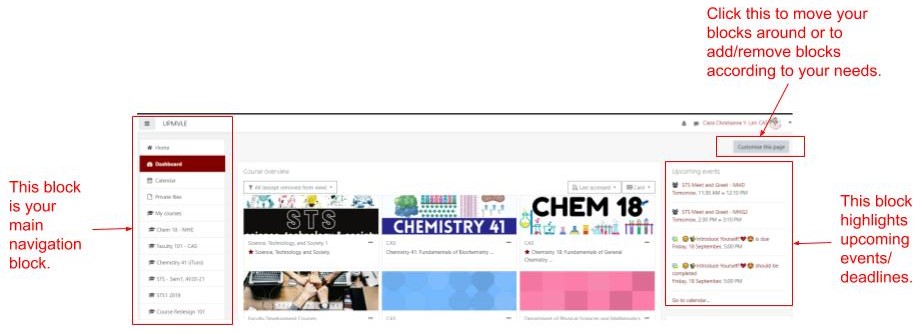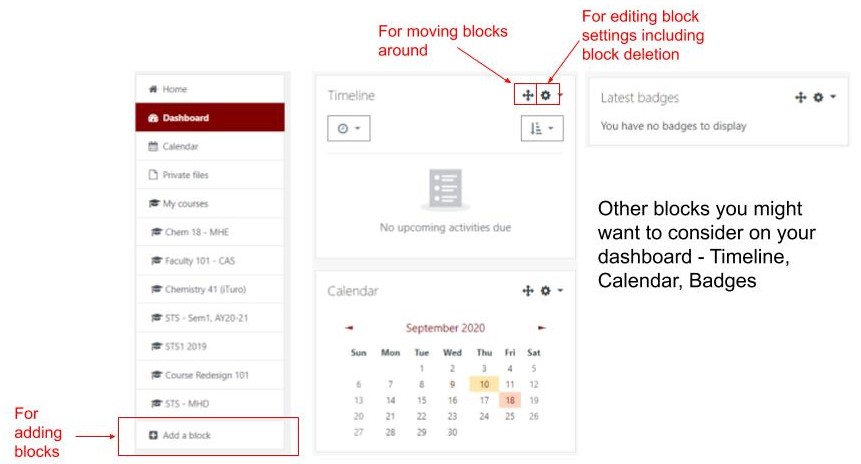Course Guide
| Site: | UP Manila Virtual Learning Environment |
| Course: | Biochemistry 125 Sandbox |
| Book: | Course Guide |
| Printed by: | Guest user |
| Date: | Tuesday, 16 December 2025, 6:08 AM |
Description
This contains the topics and goals of the course.
1. Course Description and Learning Outcomes
COURSE DESCRIPTION
This is a one (1)-unit laboratory course in physical biochemistry that seeks to characterize the physico-chemical properties of biomolecules
COURSE LEARNING OUTCOMES
After completing the course, you should be able
to:
- Explain the concepts and principles behind certain biophysical techniques
- Analyze and interpret experimental data from biophysical techniques
- Synthesize previous work found in primary literature to place the results in a broader context and propose future experiments.
- Van Holde K, Johnson WC, Ho PS. 2006. Principles of Physical Biochemistry. 2nd ed. New Jersey: Pearson Education, Inc.
- Other Journal references
2. Course Outline
Module 1 - Protein Isolation and Quantification (Group 5)
Module 2 - Spectrophotometric Determination of Iron (III) - Glycine Formation Constant (Group 4)
Module 3 – Protein Visualization using SDS-PAGE and other variations (Group 3)
Module 4 - Western Blotting and ELISA (Group 6)
Module 5 – Protein Crystallization (Group 2)
Module 6 - Relative Quantification of Riboflavin Content using Fluorometric Quenching Titration (Group 1)
Module 7 - Characterizing Protein structure through Mass Spectrometry data
Module 8 - Predicting Protein Structure using Online Bioinformatics Tools
3. Weekly Schedule
This shows the weeks where specific modules will be taken up.
|
Week No. |
Topic |
Topic Outcome |
Time Frame (hr) |
Learning Activities |
Learning Resources |
|
1 |
ORIENTATION
|
|
1.5 |
Synchronous through Zoom or other online meeting platform |
- Course Guide |
|
2 |
Protein Isolation and Quantitation |
- To explain the steps and principles in protein isolation - To evaluate protein yield |
3.0 |
Watch Video/ Perform Virtual Simulation
Submit data sheet/probset/ formal report |
- Online videos/ references - Module - Activity guide - Lab protocol |
|
3 |
Spectrophotometric Determination of Iron(III)-Glycine Formation Constant |
- To explain the concepts in metal-ligand binding and the principles behind metal-ligand coordination chemistry - To compute for metal-ligand formation constant from spectrophotometric data |
3.0 |
Watch Video/ Perform Virtual Simulation
Submit data sheet/probset/ formal report |
- Online videos/ references - Module - Activity guide - Lab protocol |
|
4 |
Protein Visualization using SDS-PAGE and other variations |
- To explain the principles behind discontinuous SDS-PAGE - To analyze and interpret protein profiles |
3.0 |
Watch Video/ Perform Virtual Simulation
Submit data sheet/probset/ formal report |
- Online videos/ references - Module - Activity guide - Lab protocol |
|
5 |
Western blotting and ELISA |
- To explain the rationale behind Western Blotting and ELISA - To interpret blot profiles and ELISA results - To expand on the applications of western blotting and ELISA |
3.0 |
Watch Video/ Perform Virtual Simulation
Submit data sheet/probset/ formal report |
- Online videos/ references - Module - Activity guide - Lab protocol |
|
6 |
Protein Crystallization |
- To explain the rationale behind hanging drop vapor method in crystallization - To compare and differentiate different precipitants in their ability to crystallize proteins - To identify the best conditions for protein crystallization |
3.0 |
Watch Video/ Perform Virtual Simulation
Submit data sheet/probset/ formal report |
- Online videos/ references - Module - Activity guide - Lab protocol |
|
7 |
Relative Quantification of Riboflavin Content of Commercially Available Food Supplements using Fluorometric Quenching Titration |
- To explain the concept behind fluorometric quenching - To quantify (relatively or absolutely) the amount of riboflavin in different samples - To explain how protein interactions can be observed through fluorescence |
3.0 |
Watch Video/ Perform Virtual Simulation
Submit data sheet/probset/ formal report |
- Online videos/ references - Module - Activity guide - Lab protocol |
|
8 |
ORAL REPORT |
|
3.0 |
|
|
|
9 |
Characterizing Protein structure through Mass Spectrometry data |
- To determine protein size through mass spectrometry (ES +) data - To determine peptide sequence through MS data |
3.0 |
Watch Video/ Perform Virtual Simulation
Submit data sheet/probset/ formal report |
- Online videos/ references - Module - Activity guide |
|
10 |
Predicting protein structure using Online Bioinformatics tools |
- To determine protein structure based on metagenomics data |
3.0 |
Watch Video/ Perform Virtual Simulation
Submit data sheet/probset/ formal report |
- Online videos/ references - Module - Activity guide - Lab protocol |
|
11 |
JOURNAL REPORT |
||||
|
12-13 |
MINI-PROPOSAL SUBMISSION/ COMPLETION OF REQUIREMENTS |
||||
4. Mode of Delivery
For this First Semester, AY 2020-2021, the course is delivered using our department’s learning management system (LMS), Courses@DPSM. The course is designed to enable independent and self-paced study among the learners through the posting of all the topics and important references that will serve as guide.
Asynchronous Sessions (required): Content will largely be delivered asynchronously meaning they can be accessed outside of the indicated SAIS class hours. Recorded lecture videos or live sessions, readings, and tasks will be uploaded. Materials on LMS as well as specific rubrics in activities will also serve as guide in the completion of requirements.
Synchronous Sessions (not required): Synchronous sessions will happen during our class hours which will also serve as our scheduled online consultation if you have any questions about the coverage.
5. Course Requirements and Grading System
Course Requirements
- Data sheets/ Probsets/ Formal report (30%)
- Quizzes/Exercises/Others (10%)
- Oral Report (15%)
- Journal Report (10%)
- Mini-proposal (35%)
Grading System
% Eq.
[92, 100] 1.00
[88, 92) 1.25
[84, 88) 1.50
[80, 84) 1.75
[76, 80) 2.00
[72, 76) 2.25
[68, 72) 2.50
[64, 68) 2.75
[60, 64) 3.00
[50, 60) 4.00
[0, 50) 5.00
6. Course Policies
By proceeding with this online class, you agree to the Code of Honor below:
"I will work on the activities on my own without the help of another person, unless said so by the instructor. I will not share course materials made available in the LMS to those who are not enrolled in this subject. I will not make solutions to homework and exams available in any way to other learners. I will not engage in any other activities that will dishonestly improve my results or dishonestly improve or damage the work of others."
(edited and adopted from https://mooc.house/)
-
Submit and comply with all course requirements.
-
Actively participate in group work and discussions through the given LMS platform whether synchronous or asynchronous and requirements.
-
Politely and respectfully interact with instructors and classmates in all remote platforms.
-
All major requirements must be completed (i.e. Journal Report, Oral, Report, Mini-proposal) otherwise a grade of DEFERRED will be given.
-
All forms of cheating/plagiarism will NOT BE TOLERATED and will merit a grade of 5.0. (Students will not be allowed to drop the course if found guilty.)
7. Guide for the Synchronous Sessions
Pre-session:
- Install an application for viewing PDF files
- Check that your phone/desktop is fully charged.
- Check that you have your charger, headsets, and other necessary equipment that you might use during our Synchronous sessions
- Log-in a few minutes early so you can check your audio and/or video prior to the start of the online session
During:
- Use your UP Mail in joining Zoom/Google (or other online platform) meetings
- Mute your microphone when you enter the room.
- Use icons to express yourself ("clap", "thumbs up" etc.). You may use the “Raise Hand” icon you want to speak (available in Zoom).
- Contact (Email or SMS) the instructor/classmate when you are having connectivity issues.
- Use the designated VLE forum or messaging for questions and concerns, so that the entire class can participate in them as well.
You will be receiving meeting details through the Announcement and Calendar blocks. These should be seen either at your Course Page or the Dashboard.
Again, synchronous sessions are NOT required and will not be the primary form of delivering content. It will largely be used for class consultations (once a week).
8. Policies for Group Work, Submissions, Questions
Please practice ACADEMIC INTEGRITY AT ALL TIMES.
Group work
- Groups are assigned at random. Please get to know your group mates, group messaging is allowed so you can contact them through the VLE messaging platform:
(found in the upper right corner of your page).
- Please use the forums for discussions so that your interactions and contributions are documented. You are allowed to speak in whatever language that suits you, however, we would like to emphasize respect and disbar foul language.
- For Group submission, a single submission from a group member will suffice.
- You will be asked to rate your team members and their contributions to a group work. Please rate them objectively.
- To all members, please actively participate and contribute to your group. They are your accountability and study team in this remote education.
Individual Work
- All assignment submissions will be via the VLE platform unless otherwise indicated by the instructor.
- Please read and follow instructions carefully especially when submission types are specified.
- If multiple submissions are done, only the most recent submission will be checked.
- Take note of deadlines and try to follow them as much as you can. We will try to post activities ahead of time so that you can make contingency plans (like internet/gadget access) in the submissions.
Quizzes
- Please assume that this is a normal classroom quiz with closed notes and no other tabs or googling available unless stated otherwise.
- Please be ready with your gadgets and internet accessibility when taking quizzes especially the timed ones.
- Please let your instructor know right away when you have trouble accessing quizzes.
Forums/Discussions
- This is the main platform for class interactions and for posting of questions or clarifications.
- For class concerns, please put them here so that others who might have the same questions will be included and will also receive the answer. DO NOT INDIVIDUALLY MESSAGE the instructor for this. It will spam our emails/message boards and we might not be able to get to your question.
- Use this platform to simulate a normal class conversation. Again, no language specifics - formal or informal is fine - as long as we are respectful to each other.
For Clarifications/Questions/Concerns
- As stated, the main platform for posting these is through the forums.
- The main methods for contacting the instructors are through the forums and message boards.
- Email addresses or mobile numbers are secondary means of communication if the first two methods fail.
- Please give us 24-72 hrs to respond to your queries.
- Live consultations (synchronous sessions) will also be platforms to address questions accumulated throughout the week or for other discussions.
9. Meet your Instructor
|
|
CIARA CHRISTIANNE Y. LIMAssistant ProfessorSection: WABEmail address: cylim1@up.edu.phMobile No.: 09988833535**use IF URGENT |

Happy learning, kiddos!
10. Explore the Moodle platform
Get to know your learning platform and its features. Look around and see what you can do with it.
Here are some sites you can check out for this:
- https://docs.moodle.org/20/en/Student_tutorials
- http://45.55.1.62/images/currentStudents/eLearning/studentResources/studentQuickStartMoodleGuide.pdf
You can also download the Moodle mobile app on your phone/tablet and configure the Courses@DPSM website (dpsm.cas.upm.edu.ph/courses) into it.
For your dashboard, here are some of the things you might want to look around on:


